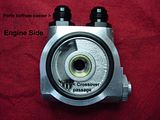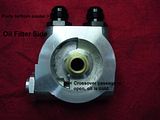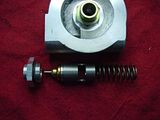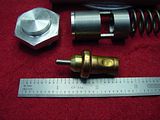I have done a remote oil filter and a remote air/oil cooler on my CSVT, removing the factory water/oil cooler. It can be more complicated than it initially appears, especially on this engine.
The first question you should ask yourself is "Do I really need and want to do this?"
Apparently you've answered yes...
If you're going to use an air/oil cooler, you should remove the water/oil-cooler between the engine and filter. You'll need to do some water line re-plumbing to bypass the water/oil cooler and route the line coming from the heater core back up to the water pump. The little metal lines that feed the oil cooler don't come out from between the block and exhaust manifold without cutting or damaging them, so be prepared to wreck them.
If you want to keep the stock filter location, you're going to need a thermostatic sandwich plate to mount to the block, this controls the flow of oil to the cooler so the oil isn't over-cooled.
Oil that is over-cooled is probably worse for your engine than oil that is too hot. You'll need
something like this from BATinc., specifically the SP1GT in 22mm thread, since M22-1.5 straight pipe is the female thread in the engine block.
So, to install this sandwich to the block, you'll need an M22-1.5 to M22-1.5 straight thread pipe nipple, these are very hard to find, but I made one from a
pressure washer hose connector, you'll need to chuck it in a lathe and machine off the wrench flats so it fits properly.
Now you need to site a proper oil cooler and run large bore lines from the sandwich plate to the cooler, I strongly recommend nothing less than 5/8" I.D. (-10 AN) lines, as these lines will be carrying ALL the oil for your engine when the oil thermostat is open and routing oil through the cooler.
When you site the new oil cooler, you need to put it somewhere where it gets cool air, AND you really should place it so it doesn't dump its heat into the engine radiator airstream, or you've sort of defeated the whole purpose of adding an external oil cooler.
Are you sure you still want to do this? :laugh:
Seriously, I have multiple-hundreds of dollars invested in my oil cooling and filtering, and if you do this wrong, either by cheaping out on components or hose size, or you blow an oil line, you'll be spinning rod bearings and building a new engine before you can say "Oh shi..."






